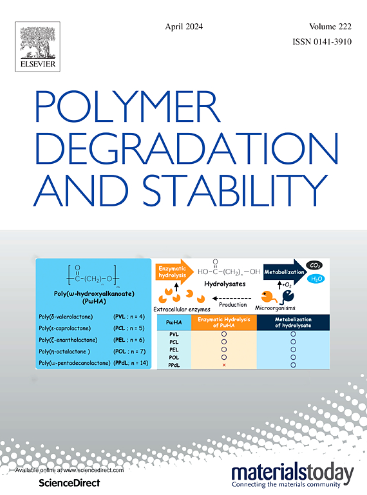Biodegradation of pre-treated low-density polyethylene (LDPE) by Yarrowia lipolytica determined by oxidation and molecular weight reduction
IF 6.3
2区 化学
Q1 POLYMER SCIENCE
引用次数: 0
Abstract
Millions of metric tonnes of plastic waste are generated every year, with a minimal portion being recycled. Therefore, there is an urgent need to find effective and sustainable methods for plastic degradation, especially polyethylene, the most manufactured polymer globally. Here, we emulate the strategies documented for beetles, characterized by a combination of physical, chemical, and microbiological treatments, to biodegrade low-density polyethylene (LDPE). Importantly, we characterize LDPE degradation through multiple techniques, including weight loss analysis, FTIR, GPC, GC–MS, and SEM, which allowed us to identify the optimal combination of treatments to enhance LDPE biodegradation. Contrary to some expectations, we find that ultrasonication does not contribute to LDPE degradation but may instead protect against its fragmentation. However, we successfully introduce carbonyl groups into the polymer backbone, by simply exposing LDPE to environmentally friendly anionic surfactant. This pretreatment effectively cleaves LDPE by approximately 9%, breaking it into shorter carbon chains that are more accessible to microbes for subsequent biodegradation. The yeast Yarrowia lipolytica, isolated from fuel tanks and able to grow in n-paraffines, not only outperforms other microbes in assays of short carbon chain degradation, but also attaches to the LDPE surface, where it survives and grows using LDPE as sole carbon source. Our findings, therefore, pave the way for further developing a potential solution to plastic waste, calling for interdisciplinary research and innovative solutions in tackling global environmental challenges.

求助全文
约1分钟内获得全文
求助全文
来源期刊

Polymer Degradation and Stability
化学-高分子科学
CiteScore
10.10
自引率
10.20%
发文量
325
审稿时长
23 days
期刊介绍:
Polymer Degradation and Stability deals with the degradation reactions and their control which are a major preoccupation of practitioners of the many and diverse aspects of modern polymer technology.
Deteriorative reactions occur during processing, when polymers are subjected to heat, oxygen and mechanical stress, and during the useful life of the materials when oxygen and sunlight are the most important degradative agencies. In more specialised applications, degradation may be induced by high energy radiation, ozone, atmospheric pollutants, mechanical stress, biological action, hydrolysis and many other influences. The mechanisms of these reactions and stabilisation processes must be understood if the technology and application of polymers are to continue to advance. The reporting of investigations of this kind is therefore a major function of this journal.
However there are also new developments in polymer technology in which degradation processes find positive applications. For example, photodegradable plastics are now available, the recycling of polymeric products will become increasingly important, degradation and combustion studies are involved in the definition of the fire hazards which are associated with polymeric materials and the microelectronics industry is vitally dependent upon polymer degradation in the manufacture of its circuitry. Polymer properties may also be improved by processes like curing and grafting, the chemistry of which can be closely related to that which causes physical deterioration in other circumstances.
 求助内容:
求助内容: 应助结果提醒方式:
应助结果提醒方式:


